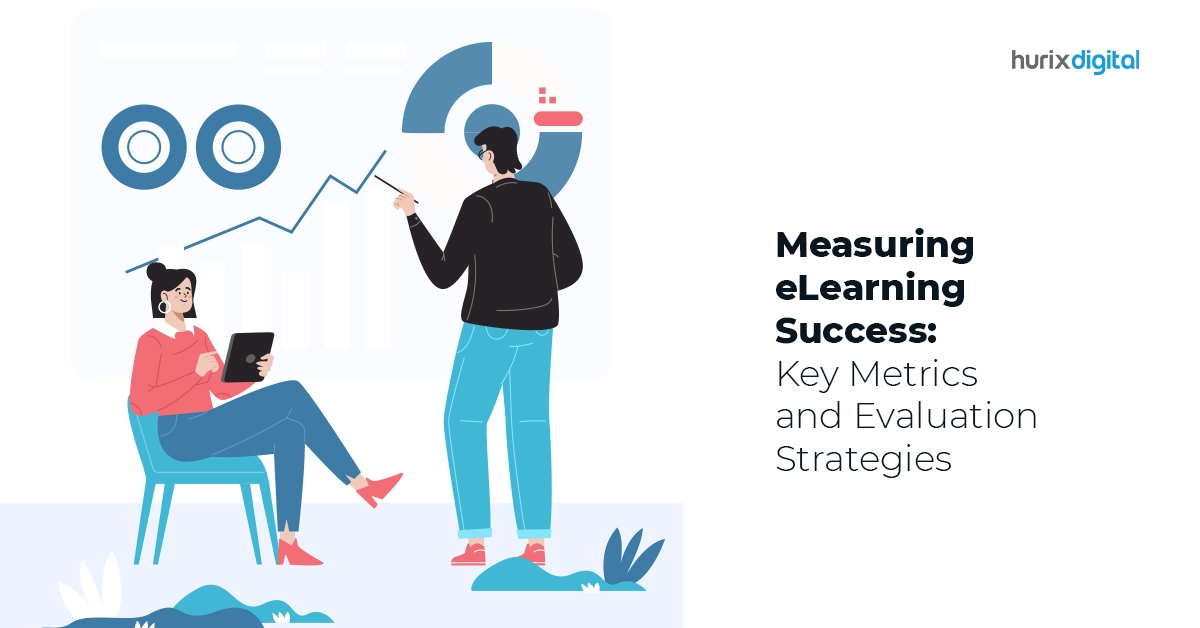Summary
Discover the critical metrics and evaluation strategies for measuring eLearning success in enterprise, workforce, and corporate learning solutions. Explore how Hurix Digital can optimize your eLearning initiatives, empowering learners and driving impactful educational experiences.
In the dynamic realm of learning and development, the rise of eLearning has reshaped training paradigms, offering unparalleled accessibility and scalability. However, the true measure of eLearning success lies in assessing its impact on learners. Evaluating the effectiveness of these initiatives necessitates a holistic approach, integrating diverse metrics and assessment strategies.
Table of Contents:
- Understanding the significance of measurement in eLearning
- Key metrics for measuring eLearning success
- Strategies for effective evaluation
- Conclusion
Understanding the Significance of Measurement in eLearning
The significance of measuring eLearning success cannot be overstated. It serves as a guiding beacon for trainers and instructional designers to refine content, delivery methods, and overall learning experiences. It empowers stakeholders to:
- Assess Effectiveness: Measurement enables the determination of how well eLearning initiatives in enterprise learning, workforce learning, and corporate learning solutions meet their intended objectives and resonate with learners.
- Identify Enhancements: Analysis of metrics helps pinpoint areas requiring enhancement, be it in content relevance, user experience, or engagement strategies.
- Validate Investments: Particularly in enterprise learning and corporate learning solutions, measuring eLearning success validates investments in technology, content creation, and training programs.
- Enhance User Experience: Understanding learner behavior and preferences empowers educators to tailor experiences, optimizing engagement and bolstering knowledge retention.
Also Read: Maximizing the ROI & Business Impact of Enterprise Learning
Key Metrics for Measuring eLearning Success
1. Engagement Metrics:
- Completion Rates: The percentage of learners who successfully complete the course serves as an initial indicator of engagement and interest.
- Time Spent: Analyzing the duration learners invest in various modules or lessons aids in assessing engagement levels and content relevance.
- Interaction Frequency: Tracking the frequency of interactions, such as quizzes taken, discussions participated in, or resources accessed, offers insights into learner engagement patterns.
2. Learning Metrics:
- Assessment Scores: Evaluating performance in quizzes, tests, or assignments is instrumental in measuring knowledge retention and understanding of the content.
- Skill Mastery: Assessing the application of acquired skills or knowledge in practical, real-world scenarios validates the effectiveness of the learning experience.
3. User Experience Metrics:
- User Feedback and Surveys: Soliciting feedback through surveys or assessments enables learners to articulate opinions on content quality, user interface, and overall experience.
- User Navigation Patterns: Analyzing how learners navigate through the eLearning platform identifies potential usability issues, contributing to improved user experiences.
4. Impact Metrics:
- Application in Real Context: Measuring the practical application of learned skills or knowledge in the workplace or real-life situations serves as a testament to the tangible impact of the eLearning program.
- ROI (Return on Investment): Especially crucial in the domain of workforce learning and corporate learning solutions, assessing the financial impact against improvements in productivity, performance, or reduced training costs is imperative.
Strategies for Effective Evaluation
1. Align Evaluation with Learning Objectives:
Establish clear learning objectives before launching an eLearning program. Ensure that evaluation strategies directly align with these objectives, ensuring measurements reflect the intended outcomes.
2. Collect Diverse Data:
Utilize a diverse array of data sources—quantitative (completion rates, assessment scores) and qualitative (learner feedback, comments)—to gain a comprehensive understanding of the learning experience.
3. Regular and Ongoing Evaluation:
Continuous assessment allows for timely adjustments. Regularly reviewing metrics facilitates identifying trends and making necessary improvements throughout the eLearning journey.
4. Compare and Benchmark:
Drawing comparisons between current eLearning initiatives and past data or industry benchmarks provides context and aids in setting realistic improvement goals.
5. Incorporate Adaptive Learning Techniques:
Leverage adaptive learning technologies that customize content delivery based on individual learner behavior. These systems can monitor progress and adapt content to suit individual learning paces and preferences, especially vital in enterprise learning environments.
Also Read: What is an eLearning Module? Know the Benefits, Challenges & Future of eLearning Modules
Conclusion
Measuring the success of eLearning initiatives stands as a pivotal aspect of their efficacy and impact. Employing a multifaceted approach encompassing engagement, learning, user experience, and overall impact metrics, stakeholders can glean invaluable insights into the effectiveness of their eLearning programs. By intertwining these metrics with robust evaluation strategies, continuous improvement becomes possible, ensuring that eLearning remains a dynamic and potent tool in the educational landscape.
For those seeking to optimize their eLearning endeavors, Hurix Digital stands as a reliable partner. With expertise in crafting tailored solutions for enterprise learning, workforce learning, and corporate learning, Hurix Digital can elevate eLearning initiatives, maximizing their impact and effectiveness. Visit our website today to explore the new possibilities.











